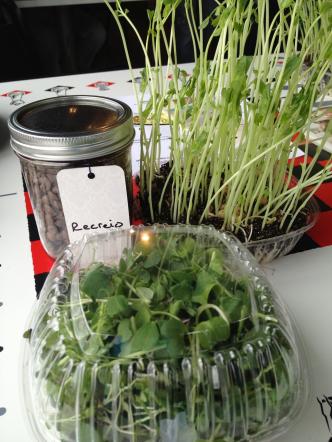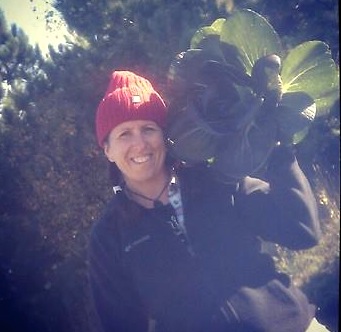This is the second post in a new SGT series that looks at CSA — community supported agriculture — from the farmer's perspective. Also check out the first post, Adventures in Farming.
People come to a CSA only partially for the vegetables. After all, you can get vegetables anywhere, from co-ops to farmers markets, and even Walmart has an organics section. What members usually want in a CSA is what we – the farmers – are eager to provide: a personal connection to the farmers, and by extension, a connection to the food. But with that link comes a set of expectations that's unique to each member. (For an overview of the CSA model in general, check out my first post here.)
For example, some members come into the CSA believing that they'll get a huge box of vegetables, every week, from the very beginning of the CSA season. While it's true that the heart of the season involves some pretty formidable boxes, the nature of farming means that the early boxes, and sometimes the later ones, will be much less abundant than people might expect. Another expectation might be variety, with one member wanting 20 pounds of tomatoes when they're in season, but another anticipating just three or four tomatoes total.
Working with a different set of expectations for each member can be tricky, and we don't always succeed, but we've found that we do best when we can anticipate those expectations, tweak them if necessary, and establish stronger relationships as a result. Here are the three major ways that we at Bossy Acres work to manage CSA member expectations, making sure that we all begin the farming season with a better sense of what's ahead:
Mandatory agreements in sign-up
We can be pretty upbeat in all our Facebook and Twitter communications (more on social media in a later post), and we love to talk about all the benefits of a CSA and, especially, the enormous value that comes with trying a wider array of vegetables. We're thrilled to be cheerleaders for organics, even if wedon't feel so bouncy after digging up radishes for six hours.
What we tend to emphasize less often is that farming comes with risks, every day. Not only is the ongoing drought a major issue, but also there are pests, hailstorms, spotty germination, compacted soil, equipment breakdowns, and quite frankly, the occasional farmer breakdown. Last year, we had several trays of valuable transplants wiped out because raccoons slipped into the greenhouse at night, enjoying a Vegas-style buffet at our expense.
To give members a sense of the conditions, we ask them to read several statements on the membership form (located here for examples) before they sign up, as a way to manage some expectations upfront. For instance, here's part of our wording for risk:
"I understand that joining a CSA is a shared reward/shared risk relationship. Bossy expects an abundant harvest but cannot always anticipate negative impacts such as poor weather/insect conditions that could result in vegetable damage/loss."
We also include a statement to indicate that when shares aren't picked up within a certain window of time, they'll be donated to a local food shelf, an option that is usually comforting for members on vacation. By making it mandatory to check off these statements, we know that members have read them and understand the risks, which is beneficial to both members and farmers.
Initial meeting before CSA begins
The CSA form statements are helpful, but they're only the first step in managing expectations. The next step is an in-person meet-up with as many members as possible. This gathering isn't mandatory — we're not evil bosses — but we encourage members to come if they can. We do our best to make it a quick meeting, and treats are involved.
 Bossy's first CSA meeting before the season beginsLast year, we all met at Blue Ox Coffee Company, one of our
dropsites, and about 40 people showed up, which is a fantastic turnout
considering that we only had 50 memberships. The meeting involved talking about
logistics like how to break down a CSA box (it's harder than you might think),
when to pick up shares, what we would communicate weekly in terms of share
contents, and other seemingly minor details that are actually major parts of a
CSA.
Bossy's first CSA meeting before the season beginsLast year, we all met at Blue Ox Coffee Company, one of our
dropsites, and about 40 people showed up, which is a fantastic turnout
considering that we only had 50 memberships. The meeting involved talking about
logistics like how to break down a CSA box (it's harder than you might think),
when to pick up shares, what we would communicate weekly in terms of share
contents, and other seemingly minor details that are actually major parts of a
CSA.
By communicating in person, we were able to field questions and get a better sense of member concerns, and most importantly, we strengthened member-to-farmer relationships. It's one thing to get to know someone on Twitter, but quite another to chat with that person in non-digital life.
Equally important, members were able to meet each other — a situation that, unfortunately, doesn't happen too much in a CSA outside of one or two farm events during the season. Yet, these are people who tend to have a great deal in common. They're obviously passionate about local food, and many share trepidation about best ways to use uncommon produce picks like kohlrabi or ground cherries. Bringing them together helps to unify them as a membership, even if this event is the only time they meet.
Bringing members together, just for one quick meeting, tends to align expectations more effectively than sending out a bunch of emails and hoping that people ask questions or express their opinions on what we've communicated.
 At Bossy's CSA meet up, members were given take-home goodies,
At Bossy's CSA meet up, members were given take-home goodies,
including pea shoots and micro greens
Email descriptions the day before CSA drop-offs
The CSA season usually begins in early June, and the first drop-off is planned when we can be sure that we'll have a steady supply of vegetables from that point forward (more on planning in the next post). By that time, we've sent out occasional emails about what's happening in the greenhouse with transplants, and we've likely had a few volunteer opportunities for planting.
With the first drop, though, begins the regular email updates that let members know on a weekly or bi-weekly basis — depending on which share type they've chosen — what they might find in their shares. This consistent communication is crucial for letting members know what to expect, especially in early shares, and particularly for those new to the CSA model.
As much as we all love surprises, opening a CSA box shouldn't be like ripping open the toy package in a Crackerjack box. Members should know precisely what's going to be in the delivery, and it's our job to provide that information. More than that, we give a farm update in the email, and maybe throw in a few photos to let them know how "their" kale is coming, or why the tomatoes will be taking longer than anticipated. Part of the appeal of a CSA is a connection to the farm, and it's realistic to expect the farmers to provide updates that strengthen that connection.
All that said, there will always be times when expectation doesn't match up with reality, and disappointment will result. Those times are tough on us, because we hate the thought of member unhappiness. But with enough communication and honesty about what members can expect, we hope those moments will be as rare as hailstorms.
In the next installment of Behind the CSA Box, I'll cover the nuances of planning for all those fabulous member-owned vegetables. Until then, stay warm and stay bossy!

Elizabeth Millard owns Bossy Acres with her partner, Karla Pankow. They grow an array of delicious vegetables in Northfield, using sustainable and organic methods. This winter, they can be found teaching classes on indoor growing at Harvest Moon Co-op, Linden Hills Co-op, Egg/Plant Urban Farm Supply, and Mother Earth Gardens. Follow them on Facebook and on Twitter at @BossyAcres.

